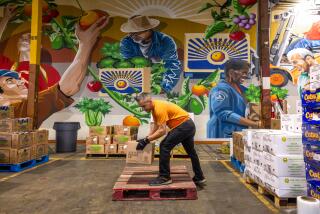Relief Effort Takes Root in Somali Soil With First Crop : Africa: International military presence is enabling farmers to return to their land and complete a harvest essential to the country’s recovery.
- Share via
FAHANE, Somalia — Until a few weeks ago, Haji Shekhey Abdi’s people were starving to death. Civil war combatants had stolen their cattle, their tractors and their food. Terrorized villagers were afraid to work in the fields or take their produce to market.
But Abdi, his four children, six grandchildren and the rest of the village recently brought in a crop of corn, their first in two years. As they have for centuries, they thanked the God of Islam. But this year they also thanked the United States.
“If the Americans hadn’t come, this crop would not be here today,” declared Abdi, a white-whiskered, 75-year-old village elder. “We planted this crop because we couldn’t just wait to die. But I never thought we’d be able to harvest it.”
The presence of 24,000 U.S. troops and about 11,000 other foreign soldiers in Somalia has engendered some controversy, both here and abroad. But one need look no further than Abdi’s five-acre plot to see the leafy results of that international military effort.
Rows of corn, the staple food, stand tall in the fields. The irrigation canals once clogged with silt now are healthy brown arteries carrying water into the countryside. And, most important, the farmers are in their fields, protected from bandits by a new and intimidating scarecrow, the 10th Mountain Division of the U.S. Army.
Beyond the daily sniper fire and the frustrating search for a political solution in Somalia is a remarkable achievement. The hungry are being fed, most of the sick are being treated, and many of the refugees are going home.
In just seven weeks, Operation Restore Hope has quashed the systematic theft of relief food and has helped guide 60 million meals to the 2 million starving Somalis.
“All the relief agencies in the country can safely get food to the people who need it, and that’s an enormous breakthrough,” said Willet Weeks of the British aid group Save the Children, which restarted its program here recently.
And now, for the first time in the history of Somalia’s famine, relief agencies are looking beyond food aid to the next step--weaning the country from donated food, getting farmers back into the fields and launching the agricultural development programs that offer the only realistic hope of putting this country back on its feet.
“The famine has peaked,” Weeks said. “There are large areas of the country that still need food. But the increase in famine deaths has ended. And if all goes well, Somalia could be feeding itself by next year.”
Some small, remote villages have not been reached yet. But their number dwindles every day. And the troops “are providing us with a dimension of logistics, from Humvees to helicopters, that we never had before,” one relief official said.
“We are between two stools,” said John Kilkenny, a development specialist with Concern, an Irish relief agency. “The food emergency isn’t completely over. But we’re starting to think about how to give people a new start and rebuild. The buzzword now is rehabilitation. “
Thousands of Somalis, sensing a new feeling of peace in their land, have left feeding centers and returned home in recent weeks. The Concern agency recently opened schools in some feeding centers, where Somalis who have been nursed back to health now heavily outnumber the ones still in desperate need of food.
And a few days ago, U.S. Marine helicopters delivered 30,000 of Concern’s “domestic rehabilitation packages” to remote villages in the famine belt.
The packages did not contain food, but rather cooking pots, bowls and spoons--the post-famine building blocks for new lives.
The immune systems of many Somalis remain weak, and disease has supplanted hunger and gunshot wounds as the chief medical problem facing relief agencies. But, with the improving security situation, the agencies are working to shore up health care in villages that foreigners had dared not enter only a few months ago.
International Medical Corps, a Los Angeles-based agency, says the number of gunshot wounds at the hospital it runs in Baidoa has fallen sharply.
And IMC officials were delighted when their doctors in Baidoa recently did a routine hernia-repair operation. The agency will soon begin training Somali health workers and expanding primary health care in the villages.
What worries relief officials these days is not the lack of food but too much food. So much food poured into Ethiopia following its 1984-86 famine that the food markets collapsed, sending prices so low that farming was no longer economically viable.
The lessons of Ethiopia are mentioned often in Somalia these days. Relief officials say Somalia’s markets are more likely to survive, if only because this country is more free-market-oriented than Ethiopia, whose rulers at the time of the famine were Marxists.
But relief agencies face a delicate balancing act, trying to get food to people who still need it without killing the incentive to farm.
Some agencies already are planning a “monetization” program, in which they will buy relief food on the local markets for those still needing it, in hopes of encouraging farmers to plant again.
“We have to be careful to make sure food gets to the people, but only as long as they need it,” said Weeks of Save the Children. “But Somalis are tired of thinking of themselves as relief recipients. They don’t want to be a permanent welfare case.”
Nowhere is that more evident than in Fahane, one of a collection of villages near Qoryooley that historically has been Somalia’s breadbasket.
Only a few years ago, farmers here produced 80% of the bananas sold in Italy and enough grain to feed nearly every one of Somalia’s 7 million inhabitants.
Fahane is located near the Shabeelle River, fewer than 100 miles southwest of Mogadishu. But getting here requires a four-wheel-drive vehicle and half a day on a rough road that is still occasionally plagued by bandits.
What first strikes a visitor is the smell of lush green vegetation, a rare scent in this country where nomadic herdsmen predominate. Today, the 270-mile network of canals here is full of crocodiles and decorated with waterlilies and papyrus.
The region was hit hard by the drought two years ago. But it was devastated by the ensuing civil war, in which President Mohamed Siad Barre first fled the capital and then tried unsuccessfully to return, only to flee again. Whether coming or going, the troops stole cattle, burned food stocks and killed anyone who got in their way.
The resulting famine sent refugees fleeing the capital for the countryside and, when the food ran out, fleeing the countryside for the provincial capitals. Relief agencies fed 10,000 refugees in Qoryooley last month.
Now, though, many of the farmers are back in their fields. Market prices for corn and for sesame, which is processed for oil, are too low to turn a profit. But the farmers planted anyway, hoping to fill their own bare cupboards.
“We had no stores of food,” said Ibrahim Humow Borow, a 56-year-old farmer. “For two years, nobody farmed because we could not. We were too weak and the bandits were too many.”
The rains have been good, and Save the Children has hired thousands of Somalis to help reopen the canals, which are vital for irrigation. The agency hopes to have the entire waterway clear by April when the second, and most important, growing season begins.
Regular U.S. Army patrols in the region discourage looting, but banditry has continued on a smaller scale. The continuing threat has curtailed the traditional harvest celebrations.
“We would be playing and dancing now,” said Abdi, the village elder. “But it would have to be at night, and many are still afraid to go out at night.”
Nevertheless, the harvest has brought a sense of relief to Fahane.
“People have peace of mind again,” said Abdullahi Mirreh, who has worked for Save the Children in this region for 12 years. “And it means they have some direction in their life.”
Added Borow: “We have a good hope for peace in Somalia. Things will get better, we hope, very soon.”
More to Read
Sign up for Essential California
The most important California stories and recommendations in your inbox every morning.
You may occasionally receive promotional content from the Los Angeles Times.










